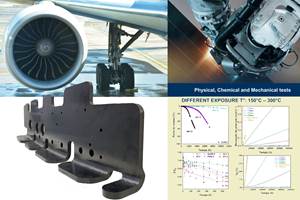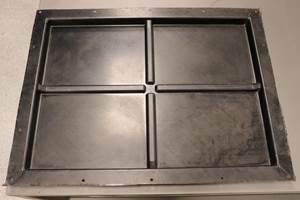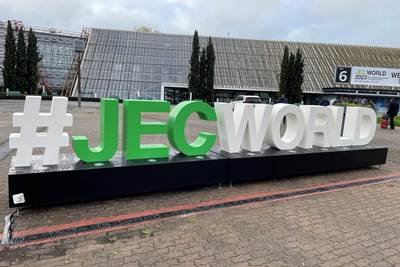It has been four years and one pandemic since the aerospace industry convened in France for the Paris Air Show. The 2023 return of one of the largest aircraft manufacturing events in the world at Aéroport Paris Le Bourget was a busy, bustling, frantic expression of pent-up energy featuring the entire aerospace supply chain, from raw materials producers to Tier fabricators to OEMs and customers. CW spent a couple days navigating this massive biennial event and captured these highlights.
Advanced air mobility
Noticeable by its presence this year was a heavy dose of advanced air mobility (AAM) exhibits, including an AAM pavilion featuring the who’s who in this dynamic emerging market. Exhibitors representing this space included Lilium, Volocopter, Archer, EHang, Ascendance, Joby Aviation, Airbus, Overair and Wisk.
Wisk. Wisk (Mountain View, Calif., U.S.) hosted a media event to introduce its Generation 6 aircraft — the version it intends to certify with the U.S. Federal Aviation Administration (FAA). Brian Yutko, CEO of Wisk, noted first that Boeing, which previously had partial ownership of Wisk, had recently fully acquired the company and made it a wholly owned subsidiary. Wisk, as a result, appears to have the deep pockets it needs to certify and bring to market its four-seat, 12-tiltrotor eVTOL.
The deep pockets will be necessary; Yutko reported that Wisk will enter the market with a fully autonomous aircraft, thereby skipping the intermediate step of coming to market with a piloted aircraft first. This means that certification for Wisk will come around 2030, and not in the 2025-2026 timeframe that other AAM firms are targeting with piloted systems. Asked about this, Yutko said that Wisk hopes early movers in the AAM space will enjoy early success and thus pave the way for Wisk as it embarks on autonomous certification: “We want our competitors to succeed,” he said. “We are cheering for them. Their success will be our success.”
Certification strategy aside, Yutko emphasized the features of the Generation 6, composites-intensive aircraft. It will offer a maximum range of 100 miles, remote human oversight from a central control location, a status display screen for each of the four passengers, bag storage in a “frunk” in the plane’s nose, and the usual array of redundant power and propulsion to enable safe landing in all situations.
The first flying Generation 6 aircraft is being designed, fabricated and assembled by Wisk’s 700 employees in Mountain View. Asked if Wisk would perform low-rate and series fabrication of composite structures or partner with a Tier manufacturer, company officials said a manufacturing strategy had been decided upon, but they were not yet prepared to discuss details.
Also, like most other AAM manufacturers, Wisk is relying on qualified composite materials and processes for its Generation 6 aircraft. And, unlike most of its competitors, Yutko said Wisk will be the direct operator of its air taxi service — at least at the start.
Overair. Overair is a Santa Ana, Calif., U.S.-based AAM entrant. It exhibited a sub-scale model of its four-tiltrotor Butterfly eVTOL alongside several full-scale components (motor, tilt actuator, battery pack) at the Paris Air Show with South Korean aerospace company Hanwha, which has invested $170 million in Overair. Valerie Manning, ex-Airbus senior executive and currently CCO of Overair, said the company is finalizing design of its full-scale aircraft, which will have a range of 100 miles and will be piloted. The company is targeting certification sometime during 2027. Manning said Overair is still developing its manufacturing strategy and determining where the cutoff will be from low-rate to high-rate manufacturing. Meanwhile, Overair is investigating locations and partner for the high-rate facility, while the initial manufacturing is taking place in Santa Ana.
Like other eVTOLs, Butterfly will be composites-intensive. And the use of just four tiltrotors — most competitors use six or more — means that Overair’s design will rely on large (approximately 20-foot) propellers that Manning says will be enablers for the aircraft’s performance.
The propellers utilize a derivative design of Karem Aircraft's OSTR blades, which provide low noise, strong mechanical performance, and helicopter-like pitch control authority to help minimize vibration through all modes of flight. This is achieved through a fully-composite, co-cured design using Toray's T1100G/3960 pre-preg system.
Archer Aviation. Attracting a lot of attention at the show was Archer Aviation’s (San Jose, Calif., U.S.) Midnight eVTOL. It features six tiltrotors on the wing leading edge and six lifter propellers on the wing trailing edge. It will have a range of 100 miles, seating for five (pilot and four passengers), a takeoff weight of 6,500 pounds and payload capacity of 5,500 pounds.
Archer CEO Adam Goldstein was at the show and spent a few minutes with CW talking about the company’s manufacturing strategy. Goldstein noted first that Archer will be holding close what it considers the company’s core IP: Powertrain and flight controls. All other technologies, he said, would be developed through partnerships.
The most notable partnership Archer has established is with automaker Stellantis (Auburn Hills, Mich., U.S.), which announced in January that it would work with Archer to construct a composites manufacturing and aircraft assembly facility in Covington, Ga., U.S. At the Paris Air Show, Goldstein said Stallantis will also produce the plane’s motors, battery packs, and wiring and harnesses.
Goldstein also said initial low-rate production (tens of units per year) of Midnight will be performed at the company’s headquarters in San Jose. Beyond that, production will enter Phase 1 at the Georgia facility, with capacity up to 650 units per year. Phase 2 production, up to 2,300 units per year, also in Georgia, will follow that, although Goldstein said a timeline for this transition has not been established — growth will depend, he said, on consumer demand and infrastructure development.
Asked about the viability of the AAM market in general, Goldstein pointed to the existing helicopter market, which he said is about 50,000 units per year but hindered by noise limits that helicopter use faces. A low-noise, lightweight, efficient mobility alternative as represented by eVTOLs in the AAM market should, he said, be able to gain a sizable share of the rotorcraft space.
Asked about the crowded AAM space and the survivability of each manufacturer as the market matures, Goldstein said, “I think, ultimately, there will be one to three players in this market, and it will come down to configuration, weight and cost.” He did not name names, but assuming Goldstein thinks Archer is one of the three survivors, and assuming that market leader Joby is a survivor, that leaves only one other eVTOL manufacturer in the mix, as Goldstein sees it. Volocopter is near the top of many eVTOL lists, and has strong financial backing, but when it comes to configuration — one pilot, one passenger — it might struggle to compete with larger aircraft like those made by Archer and Joby.
Whoever the AAM winners are, it seemed apparent at the Paris Air Show that the aerospace industry expects this mobility technology to become reality. When it comes to fruition and how much it grows obviously remains to be seen.
GKN Aerospace
At the show, GKN Aerospace (Hoogeveen, Netherlands) announced that had signed a multi-year agreement with eVTOL manufacturer Joby Aviation (Santa Cruz, Calif., U.S.) for the fabrication of thermoplastic flight control surfaces for Joby aircraft. The flight control surfaces comprise a lightweight thermoplastic structural assembly manufactured using an advanced out-of-autoclave (OOA) production method.
Arnt Offringa, director Global Technology Center Netherlands, said at the show that development and initial production work will be done at GKN’s Global Technology Centre in Hoogeveen, before transitioning to GKN Aerospace’s facility in Chihuahua, Mexico. Final products will be delivered directly to Joby’s pilot production line in Marina, California.
This contract is significant for the eVTOL/AAM market. It’s well understood that low-rate, first-generation aircraft in this space will depend primarily on already-qualified, thermoset-based, autoclave-cured composite materials. As aircraft enter high-rate production, it’s likely that increased industrialization with OOA materials and processes will be needed, with thermoplastics at or near the top of list. This step by Joby and GKN Aerospace signal a preliminary shift in this direction.
Boom Supersonic
Boom Supersonic (Denver, Colo., U.S.), which is developing a new supersonic jet aircraft — called Overture — for commercial transport, made several significant announcements at the Paris Air Show. The biggest, for the composites industry, was news that Boom has chosen its manufacturing partners for composite structures in the wings, fuselage and tail.
Boom CEO Blake Scholl announced that the wing will be fabricated by composites specialist Aeronnova (Toledo, Spain); the fuselage structures will be fabricated by Leonardo (Rome, Italy); and the tail structures, including rudder and elevators, will be fabricated by Aciturri (Miranda de Ebro, Burgos, Spain). Representatives from each company were on hand to be recognized for their selection. The supply chain for Overture is expected to be launched in 2024.
Scholl was asked about composite materials selection for Overture. He said Boom is focused on use of “proven material systems” that have “certification pedigree.” This means primarily prepregged thermoset materials with autoclave cure. Scholl did leave open the possibility of using newer materials in subsequent aircraft interations/platforms.
Scholl also provided an update on construction of Boom’s Superfactory final assembly line in Greensboro, N.C., U.S. It’s expected to be completed by mid-2024 and provide capacity for production of 33 aircraft peryear. In the meantime, the first flight test aircraft is being assembled right now and, said Scholl, is expected to make its maiden flight later in 2023. Overture is in the midst of a 10-year certification plan that, Scholl said, is expected to culminate in final certification and entry into service in 2029.
Finally, addressing sustainability, Scholl emphasized that Overture’s engine, called Symphony, will feature a turbofan design optimized to use sustainable aviation fuel (SAF). Symphony will be manufactured in Jupiter, Fla., U.S.; Scholl said Boom is working diligently with SAF manufacturers to develop a robust fuel supply chain to meet Overture’s in-service needs. Boom expects to be a net zero carbon company by 2025.
Matrix Composites
Resin transfer molding (RTM) and aircraft engine composites specialist Matrix Composites (Rockledge, Fla., U.S.), now an ITT company, reported at the Paris Air Show that it is strategically expanding its materials expertise to include high-temperature (750-800°F) resin systems, including polyamide and bismaleimide (BMI).
William Zmyndak, VP/GM aerospace at Matrix, said Matrix is looking to expand its manufacturing capabilities, particularly in closed military aircraft engines that have little or no bypass air and thus very high operating temperatures. Zmyndak noted that Matrix is keeping a close eye on the Next-Gen Fighter program and what the temperature requirements of the engine in that aircraft might be.
As part of this capability upgrade, Zmyndak said Matrix is adding new CNC capacity and improving dimensional tolerancing on its existing CNC system. Similarly, the company is adding a used RTM press to its capital equipment lineup; Matrix will have a total of six presses when this addition is complete.
Related Content
Overair's Butterfly eVTOL prototype to integrate composites-intensive design
Aiming for first flight tests in the latter half of 2023, Overair’s Butterfly aircraft uses Toray carbon fiber/epoxy prepreg strategically to cut weight on its battery-powered, quiet aircraft.
Read MoreDaher CARAC TP project advances thermoplastic composites certification approach
New tests, analysis enable databases, models, design guidelines and methodologies, combining materials science with production processes to predict and optimize part performance at temperatures above Tg (≈150-180°C) for wing and engine structures.
Read MoreUniFORM: High-quality, high-complex EV battery enclosures at low cycle times, low tooling costs
Stellantis subsidiary CpK Interior Products Inc. recently completed a design challenge to prove out its vacuum-assisted wet compression molding process for CFRP battery trays.
Read MoreSuCoHS project: Advancing composite solutions for parts with high thermal and mechanical loads
New materials, structural concepts and manufacturing using sensors for composites that resist fire, temperature and loads while providing weight and cost savings versus metals.
Read MoreRead Next
Paris Air Show orders bring aerospace industry back on track
The air show’s success was guided by nearly 1,266 order and option announcements from Airbus, Boeing, Embraer and others, indicating supply chain progress.
Read MoreCompositesWorld presents JEC 2023 recap
Post-show, CW editors share key trends in materials, technologies and equipment seen on the show floor from well-established and newer companies alike.
Read MoreFrom the CW Archives: The tale of the thermoplastic cryotank
In 2006, guest columnist Bob Hartunian related the story of his efforts two decades prior, while at McDonnell Douglas, to develop a thermoplastic composite crytank for hydrogen storage. He learned a lot of lessons.
Read More


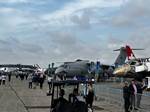








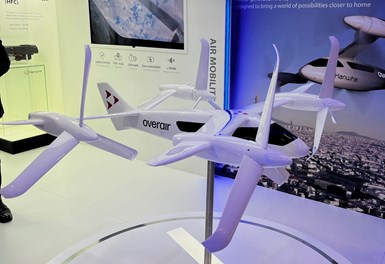
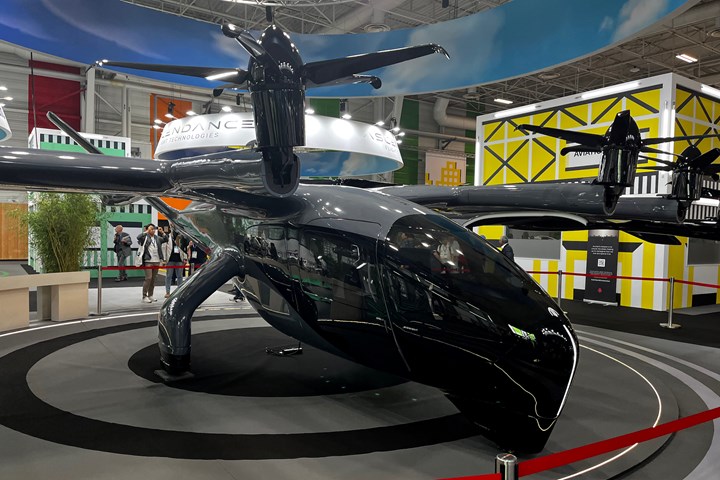

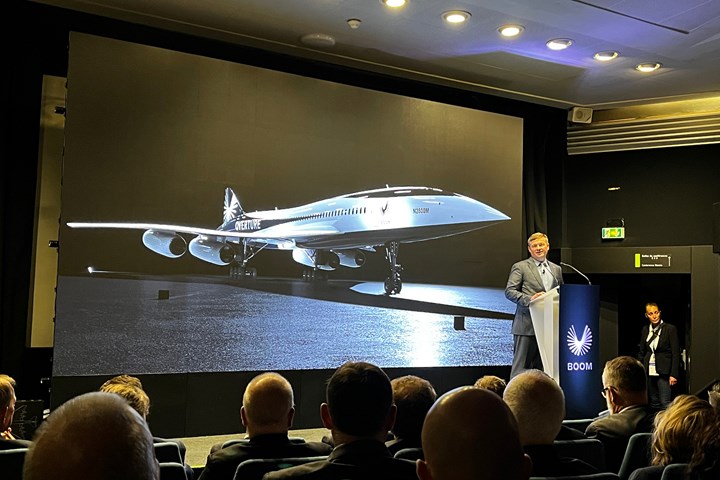




.jpg;maxWidth=300;quality=90)










